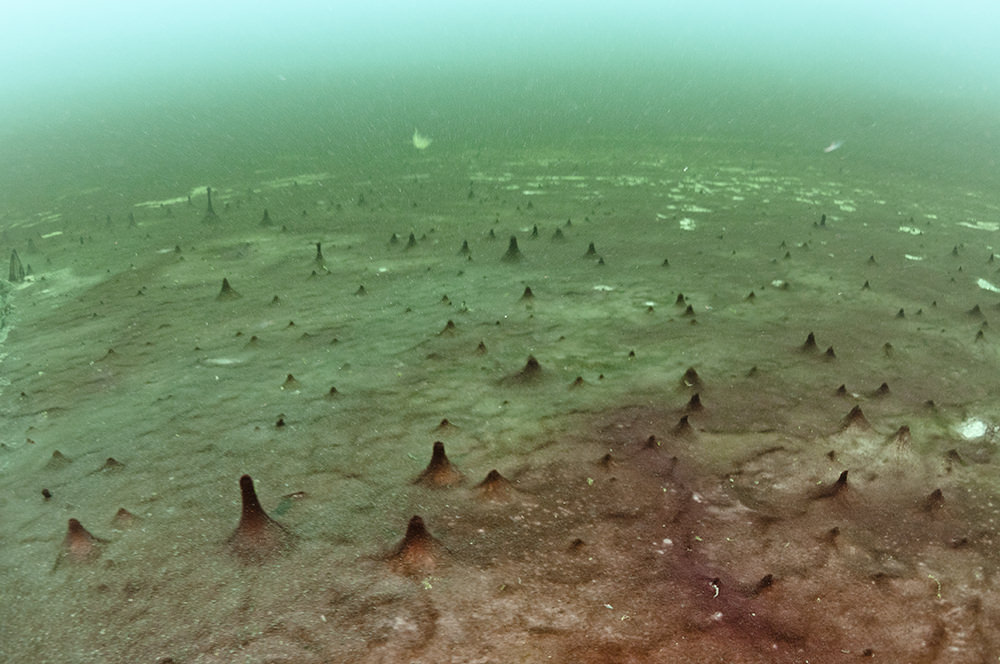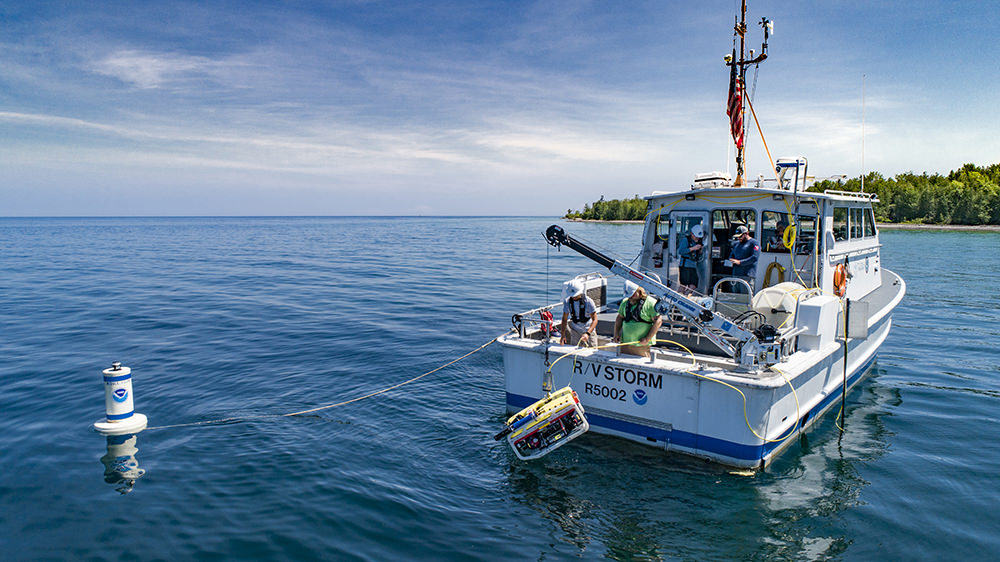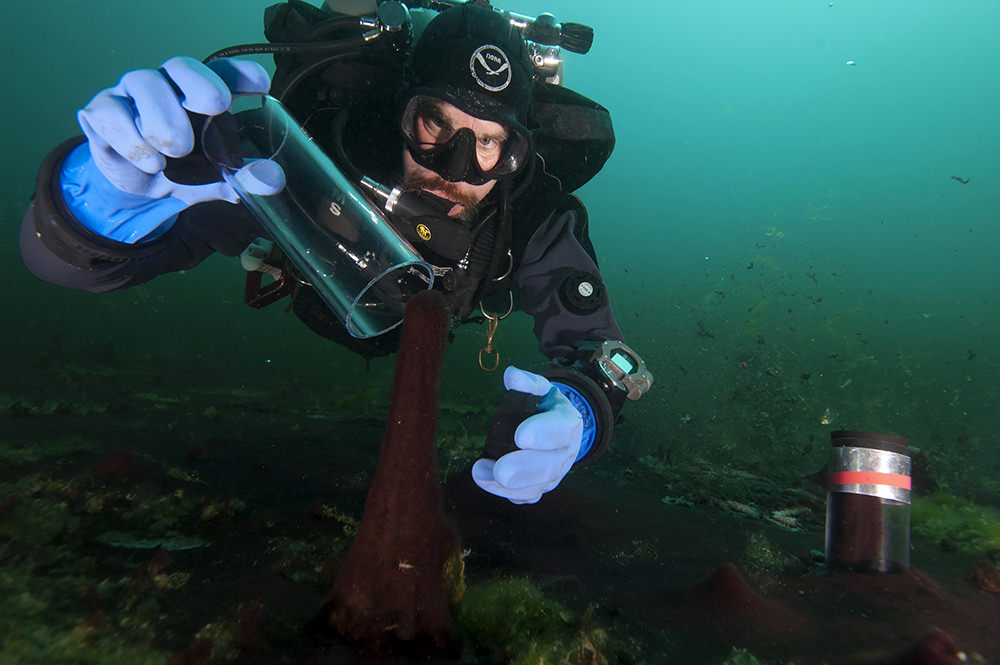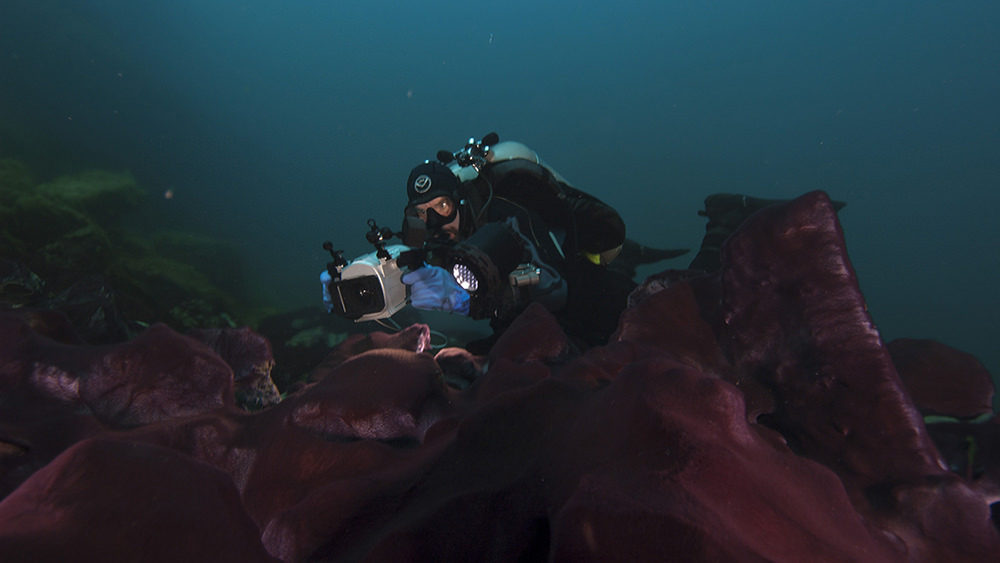Thunder Bay National Marine Sanctuary Sinkholes Hold Clues to Earth’s Distant Past
By Marissa Garcia
March 2020
Mats of purple and white drape a sinkhole in the Lake Huron lakebed near Alpena, Michigan. Hills of rock, formed by methane release, rise up from the sediment. They appear desolate but are actually the habitat for a special kind of organism, able to survive in these deep waters’ harsh conditions: microbes. This ecosystem, captured via video cameras on remotely operated vehicles (ROV), only comprises a small section of Thunder Bay National Marine Sanctuary, but is biologically fascinating. Sinkholes are like a time capsule, taking us back to how Earth may have appeared approximately 2.5 billion years ago, at the beginning of the Proterozoic Eon.
Since the sinkholes were discovered in 2002, scientists from around the world have collaborated with Thunder Bay National Marine Sanctuary to research this time capsule.
Rare sinkholes in Thunder Bay National Marine Sanctuary host unique bacterial communities that scientists have been studying for more than 15 years. Seen here are two sampling instruments situated atop large purple bacterial mats. Click and drag the image for a 360-degree view. Photo: NOAA, in collaboration with The Ocean Agency
Before There Were Modern Sea Animals, There Were Microbes
The rock that makes up Lake Huron might as well be a postcard from the past. Saltwater seas once covered the interior of the North American continent, and once these dried up, they left behind limestone, dolomite, and gypsum. Groundwater can easily seep through these rock layers. Over time, the rock becomes like a giant block of Swiss cheese, or what scientists refer to as “karst formations,” which eventually form underwater caves. As groundwater erodes the cave ceilings, the bedrock finally collapses, creating sinkholes in the lakebed.
The sinkholes have extreme conditions of high pressure, cold temperature, and low oxygen. Few organisms can survive in this environment. Certain microbes, however, thrive in these low-oxygen waters because they take advantage of another abundant nutrient found here: sulfur.
These conditions emulate the high-sulfur ocean of early Earth, which would have been inhospitable to modern animals. Microbes, however, prospered. Although little is known about the ecosystems of early Earth, sinkholes may expand our understanding about the kind of microorganisms that may have existed back then.

A unique population of microbes exists within Thunder Bay’s sinkholes. Current research suggests that purple cyanobacteria, a type of photosynthesizing bacteria, may migrate upward toward the lake surface over the course of the day in search of energy from the sun. White cyanobacteria may not travel upwards, instead using sulfur found at depths for energy production and cell growth. Other microbes, such as the forest-green Phormidium, can alternate between these two methods depending how much sulfur is available.
Dr. Bopi Biddanda, professor of water resources at Grand Valley State University, studies how these microbes use the sun and chemicals to produce energy. Understanding the microbes’ movements “may provide clues to how these mat-building organisms survived the turbulent and sharply changing chemical conditions of the early Earth,” which in turn led to the accumulation of oxygen in the atmosphere, says Biddanda. Overall, these microbes function together to create a resilient community and produce oxygen as a byproduct. Over time, the water within the sinkhole gains more oxygen. Cyanobacteria led the change in the ocean’s biochemistry millions of years ago, and now these communities may offer a lens to how Earth’s early atmosphere gained oxygen.

Collaborating to Protect Shipwrecks and Understand Sinkholes
Thunder Bay National Marine Sanctuary protects an area of Lake Huron known as “Shipwreck Alley,” due to its large number of shipwrecks. Archaeologists have so far discovered over 100 shipwrecks, and approximately 100 more are thought to be on the lakebed within the sanctuary.
Even though the sanctuary specifically protects shipwrecks, its infrastructure – including vessels, scuba divers, and research facilities – encourages collaboration among archaeologists and scientists. The technologies used for archaeological expeditions in Lake Huron enabled the discovery of sinkholes. By providing research vessels and diving resources, Thunder Bay National Marine Sanctuary has expanded in its research scope, collaborating with geneticists, chemists, and biologists.

In collaboration with Thunder Bay National Marine Sanctuary, NOAA’s National Centers for Coastal Ocean Science is undertaking a marine spatial ecology project, slated to finish in April 2020. The research team is using acoustics to map the bottom of the Great Lakes. A similar project in 2001 used sonar technology to scan for shipwrecks on the Lake Huron lakebed, which is what first led scientists to the unexpected discovery of the sinkholes. In addition to finding new sinkholes, the current project may help to find the 100 undiscovered ships in the sanctuary, adding to a world-class, historically-significant archaeological collection.

Local High School Teachers Develop Curriculum to Celebrate Sanctuaries
The archaeological and scientific endeavors in Thunder Bay National Marine Sanctuary are celebrated by the community. John Caplis and Michelle Cornish, teachers at Alpena High School, co-teach a class called “Science in the Sanctuary.” The course is centered around the sanctuary, as Caplis emphasizes the importance of “place-based education and local projects, making it relevant to students because it’s in their community.” The class builds out of an earlier class known as “Shipwreck Alley,” which used shipwrecks to teach students about Earth science and history.
In “Science in the Sanctuary,” students build their own ROVs, a hands-on introduction to marine technologies, thanks to funding from the Besser Foundation. Caplis hopes that students may one day bring ROVs down to the sinkholes.
The sinkholes represent a promising point for study. Researchers are currently investigating how water flows in and out of sinkhole bedrocks. This may shed light on how sea level changes over time. The synergy of archaeology, microbiology, and Earth science will help generate more knowledge about Thunder Bay National Marine Sanctuary and keep uniting the local community, shipwreck enthusiasts, and scientists alike.
Marissa Garcia is a student at Harvard College and a Virtual Student Federal Service intern for NOAA’s Office of National Marine Sanctuaries.

